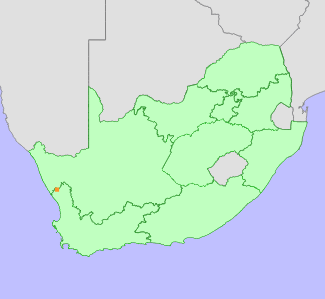|
Scientific Name | Conophytum pium S.A.Hammer |
Higher Classification | Dicotyledons |
Family | AIZOACEAE |
National Status |
Status and Criteria | Critically Endangered A4d; B1ab(v)+2ab(v) |
Assessment Date | 2021/12/02 |
Assessor(s) | A.J. Young, P.G. Desmet, I. Ebrahim, D. Guo, A. Harrower, L. Jabar, L. Knoetze, C. Rodgerson, P.C.V. Van Wyk & N.N. Mhlongo |
Justification | This succulent species is endemic to the Northern Cape province of South Africa where it is only recorded from a single location with an extent of occurrence (EOO) and area of occupancy (AOO) of 4 km2. The population is experiencing initial levels of decline due to illegal collection for the ornamental succulent plant trade, with collection likely to increase as there has been a dramatic increase in the number of species and volume of plants targeted since 2019. The continued threat of illegal collection is therefore regarded as very high for this particular species. The single location and small population size of fewer than 1,500 mature individuals makes it very susceptible to this activity and a complete decline of 100% of the population is likely within the next ten years. Climate change is also highly likely to impact the population in the long term but loss to illegal collection is more imminent. It therefore qualifies as Critically Endangered under criteria A4 and B1+2. |
Distribution |
Endemism | South African endemic |
Provincial distribution | Western Cape |
Range | This species is endemic to the Western Cape of South Africa where it is only found in a single location with a severely restricted geographic range. |
Habitat and Ecology |
Major system | Terrestrial |
Major habitats | Namaqualand Klipkoppe Shrubland |
Description | This species is endemic to Namaqualand Klipkoppe Shrubland in the Namaqualand Hardeveld bioregion of the Succulent Karoo biome. The single population is restricted to cracks and crevices in lichen covered granite domes. This species has a generation length of 30 years. It is expected to be sensitive to the impacts of climate change as it does not disperse and while adapted to arid conditions, is dependent on limited seasonal rainfall. Species in the genus are sensitive to long periods of drought. Drought related mortality has been observed for other closely related taxa within the genus. |
Threats |
| This species has been highly sought after by collectors with evidence that plants have been removed illegally from the only known location since 2019. It is highly likely to continue to be targeted in coming years. The single range-restricted location makes the taxon highly susceptible to a rapid decline in the population through a single event.
The only known, small, population is also threatened by future infrastructure development as it lies adjacent to habitation.
There is no decline in habitat quality for this taxon as inferred by changes in vegetation cover determined from changes in Enhanced Vegetation Index (EVI) between 1984 and 2018 using Landsat data (Venter et al. 2020). While it is not possible to model the response of this taxon to climate change due to its restricted distribution, the average loss to climate change for 15 more widely distributed Conophytum species occurring within the same region is used as an indication of likely impact to this species. Climate models for the likely emission scenarios where emissions stay at present day levels (RCP 2.6) (Hausfather and Peters 2020) and worst case scenarios where emissions continue to increase during the 21st century (RCP 8.5) indicate that there will be a loss of suitable bioclimatic envelope of between 72% and 99% by 2080 for Conophytum taxa within the region. However, as this taxon occurs in a very sheltered habitat it is expected to have a level of resilience to climate change and the expected population loss is reduced by 20% to 52%.Species in this genus have limited dispersal ability and migration to suitable habitats elsewhere is regarded as highly unlikely. |
Population |
It is locally abundant within suitable habitat, but a localized habitat specialist. It is currently known from a single location, despite several searches in the immediate vicinity. A site survey by the South African National Biodiversity Institute in 2021 reported a population size of no more than 1,500 mature individuals. The population is experiencing initial levels of decline due to illegal collection for the ornamental succulent plant trade.
|
Population trend | Decreasing |
Assessment History |
Taxon assessed |
Status and Criteria |
Citation/Red List version | | Conophytum pium S.A.Hammer | VU D2 | 2014.1 | |
Bibliography |
Hammer, S.A. 1993. The genus Conophytum: A conograph. Succulent Plant Publications, Pretoria.
Hammer, S.A. 2009. Conophytum confessional: three new species from South Africa. Cactus and Succulent Journal 81(4):191-195.
Hausfather, Z. and Peters, G.P. 2020. Emissions - the 'business as usual' story is misleading. Nature 577(618-620).
Opel, M.R. 2004. The rediscovery of Crassula alcicornis. Haseltonia 10:38-40.
|
Citation |
| Young, A.J., Desmet, P.G., Ebrahim, I., Guo, D., Harrower, A., Jabar, L., Knoetze, L., Rodgerson, C., Van Wyk, P.C.V. & Mhlongo, N.N. 2021. Conophytum pium S.A.Hammer. National Assessment: Red List of South African Plants version 2024.1. Accessed on 2025/11/07 |
 Comment on this assessment
Comment on this assessment


